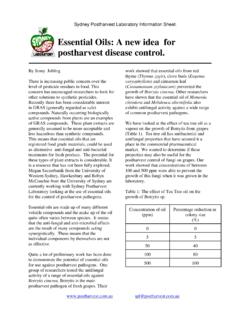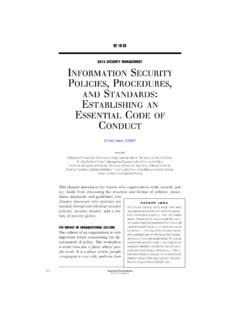Transcription of Essential Thrombocythemia Facts - lls.org
1 FS12 Essential Thrombocythemia Facts I page 1 Revised June 2012 IntroductionEssential Thrombocythemia (ET) is one of several myeloproliferative neoplasms (MPNs), a group of closely related blood cancers that share several features, notably the clonal overproduction of one or more blood cell lines. All clonal disorders begin with one or more changes (mutations) to the DNA in a single cell; the altered cells in the marrow and the blood are the offspring of that one mutant cell. Other MPNs include polycythemia vera and myelofibrosis. The effects of ET result from uncontrolled blood cell production, notably of platelets. Because the disease arises from a change to an early blood-forming cell that has the capacity to form red cells, white cells and platelets, any combination of these three cell lines may be affected and usually each cell line is affected to some degree.
2 In ET, there is mainly an overproduction of platelet-forming cells, called megakaryocytes, in the marrow. This results in the release of too many platelets into the blood. A platelet is a small blood cell. Its function is to start the process of forming a plug (clot) in response to blood vessel injury in order to prevent or minimize bleeding. When platelets are present in very high numbers they may not function normally and may cause a blockage in blood vessels, known as a thrombus. Less often, a high number of platelets can also cause bleeding problems. Another word for platelet is thrombocyte. The term Thrombocythemia means an excess of platelets in the blood. The term Essential indicates that the increase in platelets is an innate problem of the blood cell production in the bone marrow. Secondary thrombocytosis is the term for a condition that results in very high platelet counts in the blood in reaction to another problem in the patient s body, such as inflammatory disease, removal of the spleen, or iron deficiency in adults.
3 A patient with secondary, or reactive, thrombocytosis should have a return to normal platelet count in the blood once the primary problem is treated successfully. This fact sheet about ET provides information regarding diagnosis, treatment, new treatments being investigated in clinical trials and support Thrombocythemia FactsNo. 12 in a series providing the latest information for patients, caregivers and healthcare Information Specialist: Essential Thrombocythemia (ET) is one of a related group of blood cancers known as myeloproliferative neoplasms (MPNs) in which cells in the bone marrow that produce the blood cells develop and function abnormally. l ET begins with one or more acquired changes (mutations) to the DNA of a single blood-forming cell. This results in the overproduction of blood cells, especially platelets, in the bone About half of individuals with ET have a mutation of the JAK2 (Janus kinase 2) gene.
4 The role that this mutation plays in the development of the disease, and the potential implications for new treatments, are being Individuals with ET may not have symptoms. Patients with signs or symptoms may have burning or throbbing pain in the feet or hands, headaches, dizziness, blood clots or abnormal bleeding episodes. l ET does not generally shorten life expectancy. Still, medical supervision of individuals with ET is important to prevent or treat complications. FS12 Essential Thrombocythemia Facts I page 2 Essential Thrombocythemia FactsCausesThe cause of ET is not fully understood. About half of patients with ET have a mutation of the JAK2 (Janus kinase 2) gene in their blood cells. Whether or not a patient has the mutation does not appear to significantly affect the nature or course of the disease. Research is under way to determine the precise role of the JAK2 mutation in the biology of the disease and to identify other mutations in ET patients.
5 The incidence (newly diagnosed cases) of ET for all races and ethnicities is approximately per 100,000 population each year. ET occasionally occurs in older children, but is mostly diagnosed in adult men and women. The prevalence (estimated number of people alive on a certain date in a population with a diagnosis of the disease) is approximately 24 cases per 100,000 population, which has been shown in several small does not generally shorten life expectancy. However, medical supervision is important to prevent or treat thrombosis, a serious complication that can affect vital organs such as the brain or the heart. Also, for untreated pregnant patients with ET, there is a risk to the survival of the fetus. Signs, Symptoms and Complications Many patients with ET do not have any symptoms. Patients with signs or symptoms may have: l Burning or throbbing pain in the feet or hands, sometimes worsened by heat or exercise or when the legs are hanging down for long periods.
6 The skin of the extremities may have a patchy reddish color. Erythromelalgia, the medical term for this condition, is caused by diminished blood flow to the toes and fingers (microcirculation). l Headache, dizziness, weakness or numbness on one side of the body, slurred speech and other signs of inadequate flow of blood to the brain called transient ischemic attacks (TIAs). l Abnormal clotting, called thrombosis, which usually occurs in an artery but sometimes occurs in a vein. l Unexpected or exaggerated bleeding. Abnormal bleeding is infrequent and usually occurs only in the presence of a very high platelet count. l An enlarged spleen (detected by physical examination or ultrasound imaging). This occurs in about 50 percent of Constitutional symptoms like fatigue, weakness, itching, sweating and low-grade fevers, which may be present in advanced cases.
7 Thrombosis is a more common complication of ET than bleeding. This complication can be very serious if the clot blocks blood flow to an organ, such as the brain (causing a stroke) or heart (causing a heart attack). Older patients with underlying vascular disease may be at highest risk for thrombosis, but there is no precise way to gauge risk. Clotting complications can occur in patients with a slightly elevated platelet count; there is no definitive correlation between platelet number in the blood and risk of thrombosis. Uncontrolled ET can cause pregnancy complications, including: l Spontaneous abortion (miscarriage) l Fetal growth retardation l Premature delivery l Placental abruption (premature separation of the placenta and uterus). Occasionally, ET can transform into another MPN. The disease can also transform into acute leukemia or myelodysplastic syndromes or more serious bone marrow cancers, but this is a very uncommon Thrombocythemia may be considered in symptom-free patients when a blood test (done as part of a periodic health examination) shows a higher than normal platelet count.
8 Or, a doctor may order blood tests and note a markedly elevated platelet count for a patient who has a blood clot, unexpected bleeding, or a mildly enlarged platelet count is measured as part of a blood test called a complete blood count (CBC). Normal platelet values range from about 175,000 to 350,000 platelets per microliter ( L) of blood in most laboratories. ET is a consideration if the platelet count is above 600,000/ L of blood and remains high over a period of observation. Most ET patients have more than 600,000 platelets per microliter of blood. Rarely, ET is diagnosed in patients with platelet counts that are high normal (between 350,000 and 600,000 platelets per microliter of blood). Further examination and testing are needed to rule out other conditions that could be the cause of the patient s high platelet count (reactive or secondary thrombocytosis).
9 The diagnosis of ET is made on the basis ofl A high platelet count that persists over time l The presence of the of JAK2 mutation (found in about half of ET patients) or any other molecular or genetic abnormality in the patient s blood or bone marrow cell FS12 Essential Thrombocythemia Facts I page 3 Essential Thrombocythemia Factsl The absence of evidence for other clonal blood diseases that can be accompanied by increased platelets (usually requires examination of the bone marrow) and no evidence for any other condition that would cause a reactive increase in a bone marrow examination is not strictly necessary to make the diagnosis, it is often done because it can help to confirm the diagnosis and to exclude other bone marrow diseases that can cause high platelets. The marrow of a patient with ET shows a significant increase in platelet-forming cells (megakaryocytes) and masses of platelets.
10 Generally, a doctor will consider other conditions first to determine if any of them are the cause of the increase in platelets. Several conditions can cause an increase in platelets; for example: l Inflammatory disorders such as active arthritis or gastrointestinal inflammatory disease l Iron deficiency anemia l An undetected (occult) cancer l History of splenectomy (removal of the spleen).Treatment Planning Treatment decisions are based on the patient s risk for clotting or bleeding complications. For some patients with no signs of the disease other than an increased platelet count, the risk of complications may be low and no therapy is needed. On the other hand, in patients with previous bleeding or clotting episodes, or in patients who are at high risk for such complications, doctors may use medications to reduce high platelets. Risks for clotting complications (thrombosis) include: l A history of a clot l Advanced age (over 60 years)l Cardiovascular risk factors, such as high cholesterol, diabetes, smoking, obesity or hypertension all considered by many doctors as additional risk factors for thrombosis.

















